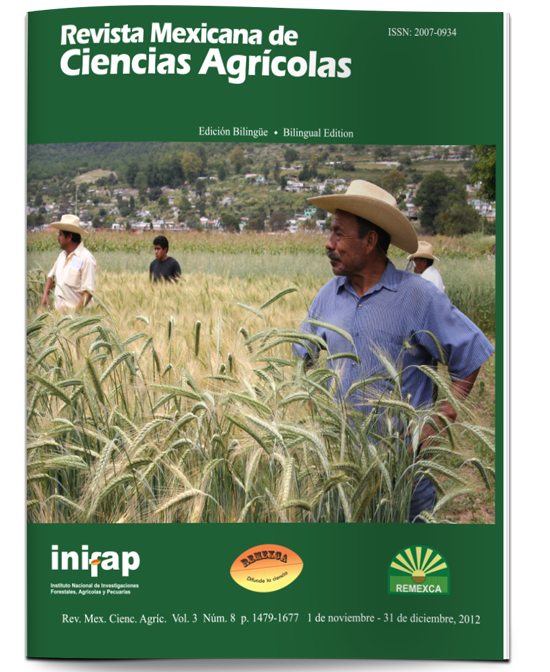Pinto Centennial, new variety of beans for the state of Durango
DOI:
https://doi.org/10.29312/remexca.v3i8.1330Keywords:
Phaseolus vulgaris L., quality, marketing, yieldAbstract
Farmers who grow beans (Phaseolus vulgaris L.) under rainfed conditions require early varieties producing grain tolerant to darkening and greater size in relation to Pinto Saltillo, which is the most popular variety in Durango. The objective was to obtain a bean variety than Pinto Saltillo in earliness, grain size and commercial quality. The Pinto Centennial (PT08034) was generated with the pedigree method, from the cross between Pinto and Pinto Mestizo Saltillo [(Pinto Mestizo / Pinto Saltillo) -7 to 5]. Pinto Centennial showed a yield (1 242 kg ha-1) statistically similar to Pinto Saltillo (1 201 kg ha-1), was found early maturity (89 vs 92 days) and 100 seed weight was significantly higher (35 g vs 30 g) with an interval between 26 and 45 g/100 seeds. The growth habit of Pinto Centennial is of an indeterminate vine with short non-climbing guides, the canopy has an average height of 27 cm and a growing guide of 75 cm. The transverse and longitudinal form of the Pinto Centennial seed is elliptical and the seed coat is cream-colored, pinto brown and a yellow hilum. Under field conditions, the Pinto Centennial plant showed tolerance to diseases such as anthracnose and rust, as well as intermediate susceptibility to common blight and root rot. Pinto Centennial was included in validation programs in the highlands of Mexico to establish its possibilities of adoption, adaptability and potential to increase yield and quality of beans produced in the region.
Downloads
Downloads
Published
How to Cite
Issue
Section
License
The authors who publish in Revista Mexicana de Ciencias Agrícolas accept the following conditions:
In accordance with copyright laws, Revista Mexicana de Ciencias Agrícolas recognizes and respects the authors’ moral right and ownership of property rights which will be transferred to the journal for dissemination in open access. Invariably, all the authors have to sign a letter of transfer of property rights and of originality of the article to Instituto Nacional de Investigaciones Forestales, Agrícolas y Pecuarias (INIFAP) [National Institute of Forestry, Agricultural and Livestock Research]. The author(s) must pay a fee for the reception of articles before proceeding to editorial review.
All the texts published by Revista Mexicana de Ciencias Agrícolas —with no exception— are distributed under a Creative Commons License Attribution-NonCommercial 4.0 International (CC BY-NC 4.0), which allows third parties to use the publication as long as the work’s authorship and its first publication in this journal are mentioned.
The author(s) can enter into independent and additional contractual agreements for the nonexclusive distribution of the version of the article published in Revista Mexicana de Ciencias Agrícolas (for example include it into an institutional repository or publish it in a book) as long as it is clearly and explicitly indicated that the work was published for the first time in Revista Mexicana de Ciencias Agrícolas.
For all the above, the authors shall send the Letter-transfer of Property Rights for the first publication duly filled in and signed by the author(s). This form must be sent as a PDF file to: revista_atm@yahoo.com.mx; cienciasagricola@inifap.gob.mx; remexca2017@gmail.
This work is licensed under a Creative Commons Attribution-Noncommercial 4.0 International license.



